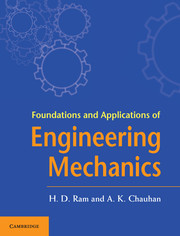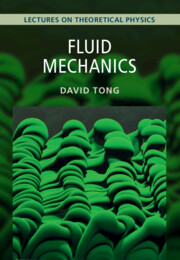Refine search
Actions for selected content:
8124 results in Fluid dynamics and solid mechanics

Microstructural Rheology of Complex Fluids
- Coming soon
-
- Expected online publication date:
- April 2026
- Print publication:
- 31 March 2026
-
- Book
- Export citation
Random Vibrations
- A Primer
- Coming soon
-
- Expected online publication date:
- February 2026
- Print publication:
- 28 February 2026
-
- Textbook
- Export citation
EDITORIAL: SPECIAL ISSUE IN HONOUR OF PROFESSOR ANTHONY ROBERTS
-
- Journal:
- The ANZIAM Journal / Volume 67 / 2025
- Published online by Cambridge University Press:
- 29 October 2025, e36
-
- Article
-
- You have access
- HTML
- Export citation
DYNAMICS OF NONLOCAL KURAMOTO–SIVASHINSHY EQUATIONS WITH MULTIPLICATIVE WHITE NOISE
- Part of
-
- Journal:
- The ANZIAM Journal / Volume 67 / 2025
- Published online by Cambridge University Press:
- 23 October 2025, e34
-
- Article
- Export citation
CONSTRAINED FRACTIONAL OPTIMIZATION PROBLEMS AND CORRESPONDING SADDLE-POINT OPTIMALITY CRITERIA
- Part of
-
- Journal:
- The ANZIAM Journal / Volume 67 / 2025
- Published online by Cambridge University Press:
- 23 October 2025, e35
-
- Article
- Export citation
CLASSIFICATION OF PERIODIC ORBITS FOR SQUARE AND RECTANGULAR BILLIARDS
- Part of
-
- Journal:
- The ANZIAM Journal / Volume 67 / 2025
- Published online by Cambridge University Press:
- 08 October 2025, e33
-
- Article
-
- You have access
- Open access
- HTML
- Export citation
WAVE INTERACTION WITH AN H-SHAPED SUBMERGED BREAKWATER
- Part of
-
- Journal:
- The ANZIAM Journal / Volume 67 / 2025
- Published online by Cambridge University Press:
- 15 September 2025, e32
-
- Article
- Export citation
WATER WAVE SCATTERING BY
 $\large \boldsymbol {\sqcap }$-SHAPED AND INVERTED
$\large \boldsymbol {\sqcap }$-SHAPED AND INVERTED  $\large \boldsymbol {\sqcap }$-SHAPED POROUS BREAKWATERS
$\large \boldsymbol {\sqcap }$-SHAPED POROUS BREAKWATERS
-
- Journal:
- The ANZIAM Journal / Volume 67 / 2025
- Published online by Cambridge University Press:
- 05 September 2025, e31
-
- Article
- Export citation
REDUCING ENERGY DURING SPECIFIED TIME INTERVALS FOR MULTIPLE TRAINS USING SIMPLE TRAIN MODELS
- Part of
-
- Journal:
- The ANZIAM Journal / Volume 67 / 2025
- Published online by Cambridge University Press:
- 26 August 2025, e30
-
- Article
-
- You have access
- Open access
- HTML
- Export citation
BIFURCATION ANALYSIS AND FAST APPROACH OF A LESLIE-TYPE PREY–PREDATOR MODEL INVOLVING ALLEE EFFECT
- Part of
-
- Journal:
- The ANZIAM Journal / Volume 67 / 2025
- Published online by Cambridge University Press:
- 22 August 2025, e29
-
- Article
-
- You have access
- Open access
- HTML
- Export citation
RESONANT DYNAMIC B-TIPPING CLOSE TO A NONSMOOTH SADDLE-FOCUS BIFURCATION LINKED TO CLIMATE CHANGE
- Part of
-
- Journal:
- The ANZIAM Journal / Volume 67 / 2025
- Published online by Cambridge University Press:
- 05 August 2025, e28
-
- Article
-
- You have access
- Open access
- HTML
- Export citation
FULLY DECOUPLED ARBITRARILY HIGH-ORDER CONSERVATIVE SCHEMES FOR THE SCHRÖDINGER–BOUSSINESQ EQUATION
- Part of
-
- Journal:
- The ANZIAM Journal / Volume 67 / 2025
- Published online by Cambridge University Press:
- 25 July 2025, e27
-
- Article
- Export citation
A DELAY DYNAMICAL SYSTEM’S PERSPECTIVE ON THE GLUCOSE–INSULIN REGULATORY RESPONSE TO ON–OFF GLUCOSE INFUSION
- Part of
-
- Journal:
- The ANZIAM Journal / Volume 67 / 2025
- Published online by Cambridge University Press:
- 22 July 2025, e26
-
- Article
-
- You have access
- Open access
- HTML
- Export citation
SPATIAL PATTERN FORMATION IN A MODEL OF THE BRAY–LIEBHAFSKY REACTION
- Part of
-
- Journal:
- The ANZIAM Journal / Volume 67 / 2025
- Published online by Cambridge University Press:
- 07 July 2025, e24
-
- Article
-
- You have access
- Open access
- HTML
- Export citation
SIAMESE NETWORKS FOR POINCARÉ EMBEDDINGS AND THE RECONSTRUCTION OF EVOLUTIONARY TREES
- Part of
-
- Journal:
- The ANZIAM Journal / Volume 67 / 2025
- Published online by Cambridge University Press:
- 07 July 2025, e25
-
- Article
- Export citation

Foundations and Applications of Engineering Mechanics
-
- Published online:
- 26 June 2025
- Print publication:
- 16 March 2015
-
- Textbook
- Export citation

Fluid Mechanics
- Lectures on Theoretical Physics
-
- Published online:
- 26 June 2025
- Print publication:
- 19 June 2025
-
- Textbook
- Export citation
EDITORIAL: AT THE FRONTIER OF APPLIED DYNAMICAL SYSTEMS SPECIAL ISSUE IN HONOUR OF PROFESSOR BERND KRAUSKOPF (On the occasion of his 60th birthday)
- Part of
-
- Journal:
- The ANZIAM Journal / Volume 67 / 2025
- Published online by Cambridge University Press:
- 25 June 2025, e23
-
- Article
-
- You have access
- HTML
- Export citation
1 - Inviscid Flows
-
- Book:
- Fluid Mechanics
- Published online:
- 26 June 2025
- Print publication:
- 19 June 2025, pp 8-64
-
- Chapter
- Export citation
Contents
-
- Book:
- Fluid Mechanics
- Published online:
- 26 June 2025
- Print publication:
- 19 June 2025, pp vii-xii
-
- Chapter
- Export citation










